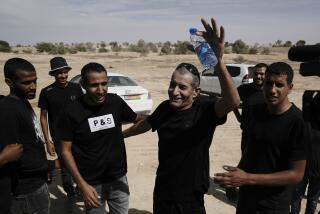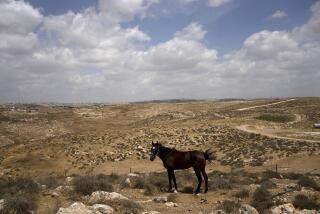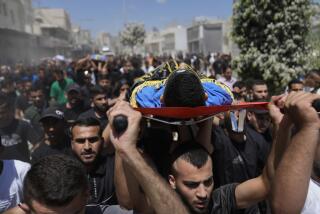Sharon’s West Bank Folly
The ambush killings of a dozen Israeli security troops charged with protecting settlers on what Palestinians consider stolen land give prominence to the issue of Israeli settlements on West Bank territory. The settlements are an obstacle to peace and a drain on Israel, yet Prime Minister Ariel Sharon’s government is considering expanding the enclave on the edge of the West Bank city of Hebron, where the killings occurred Friday.
Jews and Muslims revere Hebron as the burial place of the biblical patriarch Abraham / Ibrahim and consider it sacred. Israeli security forces consider the city a daunting challenge because 450 Israeli settlers live inside it surrounded by 120,000 Palestinians.
On the edge of Hebron, in Kiryat Arba, near the southern end of the West Bank, live several thousand Israelis on land occupied after the 1967 war. To get to the Tomb of the Patriarchs to pray, Kiryat Arba settlers use a road through densely populated Arab neighborhoods. The road was the site of the three-hour gun battle in which nine Israeli soldiers and border patrolmen and three armed guards from Kiryat Arba were killed, along with three Palestinian attackers. Soon after the killings, settlers began building an outpost on the site.
Violence continued in the West Bank Tuesday as Israeli soldiers killed five Palestinians, including one allegedly involved in a January attack that killed six Israelis. In Gaza, two alleged gunmen were slain by Israeli soldiers outside a Jewish settlement.
The United States rightly condemned Islamic Jihad, the terrorist group that took responsibility for Friday’s ambush, and called on its Syrian patrons to shut it down. Such terrorism accomplishes nothing for its perpetrators; it merely reminds the world that groups like Islamic Jihad continue to deny Israel’s right to exist.
The settlements are unpopular with many Israelis, and in June President Bush followed the lead of previous U.S. administrations, saying, “Israeli settlement activity in the occupied territories must stop.”
In January 1997, in a U.S.-brokered agreement, Israel turned over 80% of Hebron to Palestinian control but kept the Jewish enclave. Since then the city has witnessed frequent clashes, pulling Palestinians and Israelis further apart. If Palestinian land is taken to build a secure corridor between Kiryat Arba and the tomb, tension will increase in a city that is always on edge.
The 1997 Hebron agreement once seemed a promising, if fragile, extension of the process that would bring permanent peace between Israel and the Palestinians. That continuum was interrupted nearly two years ago by a failure to agree on how to exchange land for peace, and it was shredded by the renewed Palestinian uprising.
However, the chances of peace could get even worse. How? Through the demolition of Arab houses, the forced evacuation of residents in linking Kiryat Arba and the Tomb of Patriarchs, and allowing machine-gun- toting settlers to guard the route.
More to Read
Sign up for Essential California
The most important California stories and recommendations in your inbox every morning.
You may occasionally receive promotional content from the Los Angeles Times.










